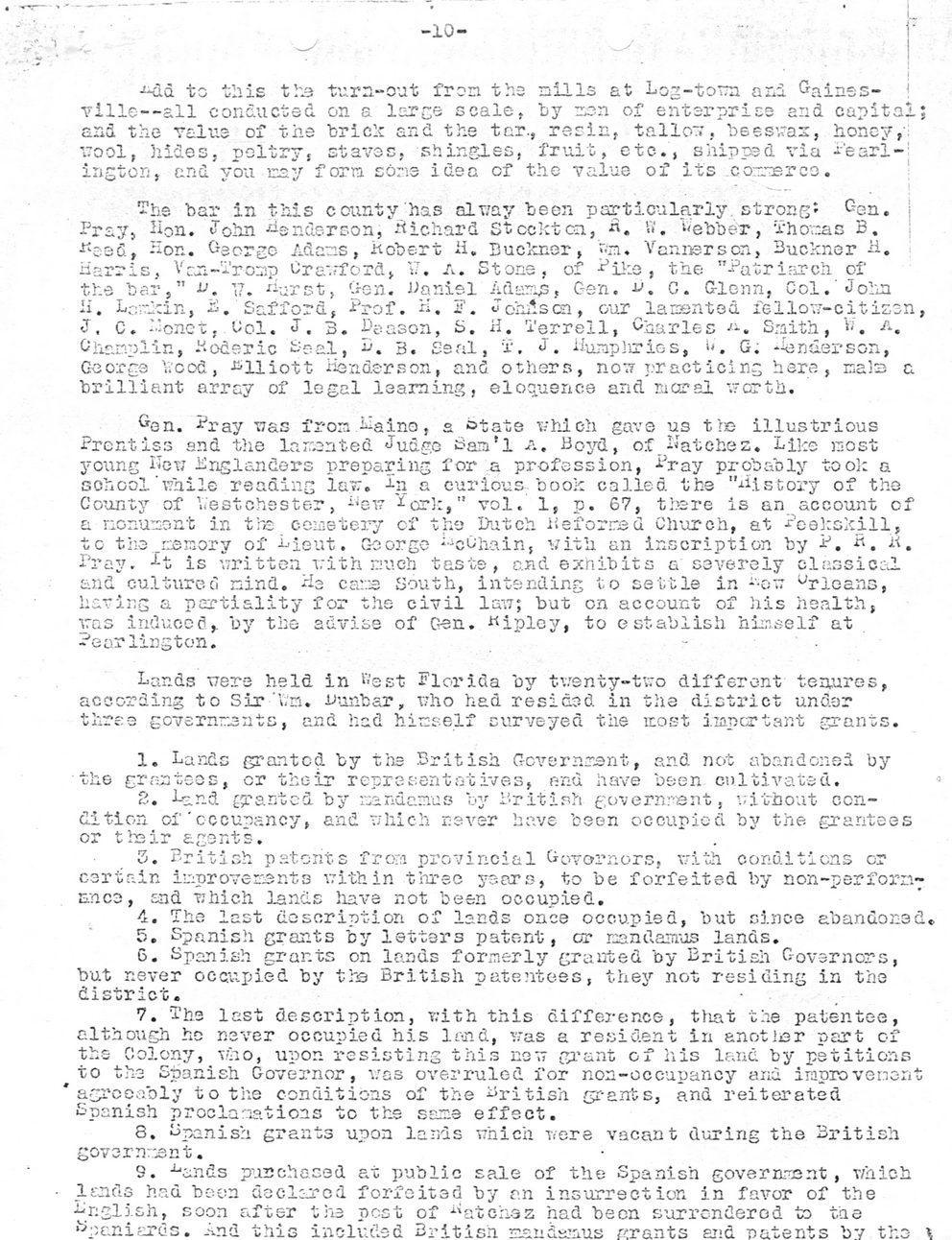This text was obtained via automated optical character recognition.
It has not been edited and may therefore contain several errors.
-10- ^-dd to tliis the turn-out from. the nills at Log-town and Gainesville—all conducted on a large scale, by z,3n of enterprise and capital; and the Talus of the brick and the tar., resin, talloT. beesvTas, honey,-iTool, hides, peltry. staves, shingles, fruit, etc., shipped via -earl-: ingtori, end you may form some idea of the value of its cor$rco. rru -he bar in this county has alway been particularly strong*' GGn. Pray, Hon. John Henderson, Richard Stccktca, «. W. Webber, Thomas B. ^eed, -ion. George Adams, Robert ii. Buckner, pn. Vanns r s cn, Buckner H. Harris, Ven-Tromp Crawford, \7. a. Stone, of Pike , the "Patriarch of the bar,” v, 17. ^urst, G-en. Daniel Adams, Gen. v. C. G-lenn, Col.' John H. Lcirucin, £.' Saffor& t Prof. H. F. ^oiulscn, our lamented fellow-citisen, J, C. Monet, Col. J. 3. peason, S. tf. Terrell, Charles <«•. Smith, V<. a. Ohanplin, Koderic teal, 3. Seal, x. J. Humphries, u. G. Anderson, George \i'cod, ^lliott Henderson, and others, no? practicing here, rials a brilliant array of legal learning, eloquence and moral worth. Gen. Pray was from l^aine, a ©tate which gave us the illustrious Prentiss and the lamented Judge ^am'l a. Boyd, of batches, Like most young Hot; Englanders preparing for a profession, Pray probably took a school"while reading law. a curious book called the "History of the County of Westchester, i;ew '*or3-:," vol. 1, p. 67, there is an account of a monument in the cemetery of the Dutch n efor.ee d Church, at Peekskill, to the. esiaory of i>ieut. George ^cOhain, with an inscription by P. i<. Pray, ^t is written with much taste, and exhibits a severely classical and culture cl mind. Hs came South, intending to settle in *-ow Orleans, having a pertiality for the civil la1.?; but on account of his health, ires induced* by the advise of G-en. Ripley, to establish himself at Pearlington. - Lands were held in r>est Florida by twenty-two different tenures, according to Sir ‘Win. Dunbar, who had resided in the district under three governments, and had himself surveyed the most important grants. 1. Lands granted by the British Government, and not abandoned by the grantees, or their representatives, find have been cultivated. 2. Land granted by r:andamuq by i'-ritish go-vernr’snt, without condition of'occupancy, and which never have been occupied by the grantees or their agents. Z. British patents frora provincial Governors, with conditions or certain improvements within .three years, to be forfeited by non-perform nnce, End which lands have not been occupied. 4. The last description of lands once occupied, but since abandoned* 5. Spanish grants by letters patent, or mandamus lands. 6. Spanish grants on lands formerly granted by British Governors, but never occupied by tha British patentees, they not residing in the district. 7. The last description, with this difference, that the patentee, although he never occupied his land, was a resident in anotler part of the Colony, who, upon resisting this now grant of his land by petitions to the Spanish Governor, was overruled for non-occupancy and improvement 'agreeably to the conditions of the British grants, and reiterated Spanish proclaroations to the same effect. 8. Spanish grants upon lands which were vacant during the British govern:.:ent. 9. x,ands purchased at public sale of the Spanish governmsnt , which lends had been declared forfeited by an insurrection in favor of the English, soon after tha pest of A'atcaaz had been surrendered to the fcpanierus. And this included British mandamus grants and patents by the \

Hancock County 1 Claiborne-JFH-July-4-1876-address-Joe-Pilet-(051)